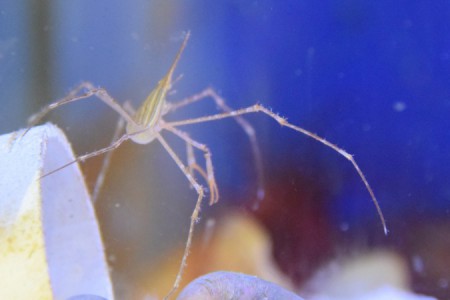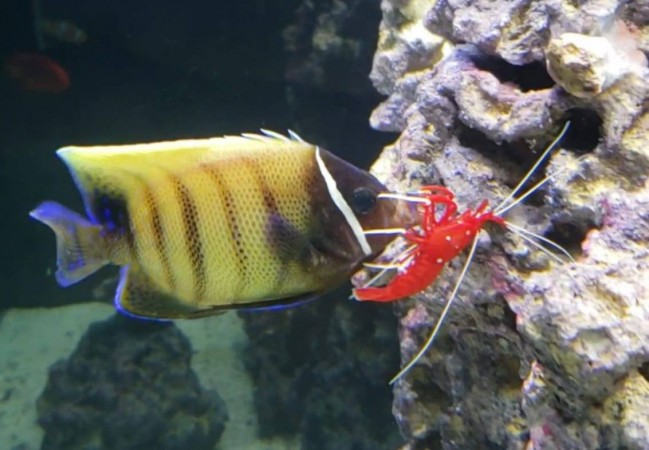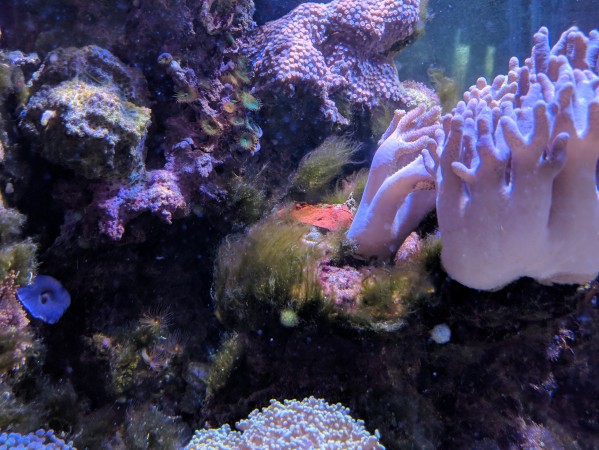- Name:
Arrow Crab
(View AKA's) - Family: Majidae
- Species: Crab
- Scientific Name: Stenorhynchus seticornis


-
Difficult
Care Level
-
Aggressive
Temperament
-
Omnivore
Diet
-
100%
Reef Safe
- 79
Temp (Temperature)
- 7.9
pH (pH)
- NAN
NH3-4 (Ammonia)
- 1
NO3 (Nitrate)
- 0.1
PO4 (Phosphate)
- 9
AT (Alkalinity)
- 440
Ca (Calcium)
- 1320
Mg (Magnesium)
- 1.025
SG (Salinity)
- NAN
ORP (Oxidation Reduction Potential)
- 0
Avg. Size (Inches)
- 29
Avg.Tank Size (Gallons)
- 5
Avg Life (Years)
General info about Arrow Crab
The Arrow Crab has extremely long legs. It is called the Arrow Crab because of the shape of the body and head. The size is variable, many reaching six inches, and some up to 10 inches. Females may be dramatically smaller. Different species inhabit different parts of the world. They normally inhabit portions of the reef usually associated with a small cave or crevice. It is a hardy, long-lived invertebrate, that can be housed in the reef aquarium. This crab has been known to attack crustaceans such as Banded Coral Shrimp, and may even attack small slow moving fish.
Arrow Crab Diet & Nutrition
Arrow Crab is a nocturnal scavenger. Its diet mainly consists of small feather duster worms and small animals found in coral reefs. It also feeds on slow-moving fish and bristles worms. They are considered safe when inside an aquarium, but they must be adequately fed with meat and pellet food. It is commonly placed in an aquarium to control the growth of bristle worms.
Determining Sex of Arrow Crab
Arrow crabs are hard to sex, but males are generally larger than females.
Breeding & Spawning Arrow Crab
A male arrow crab holds the female crab against his belly and deposits a sperm packet. The female then carries the eggs until they are full grown and are ready to be hatched. Breeding inside the aquarium is usually unsuccessful. This may be because these crabs prefer to breed naturally than intentionally.
Arrow Crab Origin
The arrow crab is native from the coral reefs of the Atlantic Ocean, from North Carolina and Bermuda up to Brazil and Caribbean. It is also common in the reefs of Florida and Texas. It can be found between the depths of 10 and 30 feet.
Caution with Arrow Crab
Arrow crab is territorial so no other crab species can be placed in the aquarium when it is present. However, it can live harmoniously with the sea anemone (Lebrunia danae), Pederson's cleaning shrimp (Ancylomenes pedersoni) and spotted cleaner shrimp (Periclimenes yucatanicus).
Acclimating Arrow Crab
When taking the invertebrate out, expose it to as little light as possible and turn the aquarium lights off. Place the invertebrate container bag in the aquarium and let it float for 15 minutes. Open the bag and pour in 1 ounce of aquarium water into it, do so every 5 minutes until the water inside the bag has doubled. Wait for 5 minutes before pouring off half the water inside the bag into the aquarium. Then, slowly place each animal in the aquarium. Turn the aquarium lights on after an hour or more.
Original Detail
| Name | Species | Family | Scientific Name | More Detail | Added by |
|---|---|---|---|---|---|
| Arrow Crab | Crab | Majidae | Stenorhynchus seticornis | The Arrow Crab has extremely long legs. It is called the Arrow Crab because of the shape of the body and head. The size is variable, many reaching six inches, and some up to 10 inches. Females may be dramatically smaller. Different species inhabit different parts of the world. They normally inhabit portions of the reef usually associated with a small cave or crevice. It is a hardy, long-lived invertebrate, that can be housed in the reef aquarium. This crab has been known to attack crustaceans such as Banded Coral Shrimp, and may even attack small slow moving fish. |
PalaciosAn |
Changed by users
| Submitted Date | Submitted By | Status | Action |
|---|



